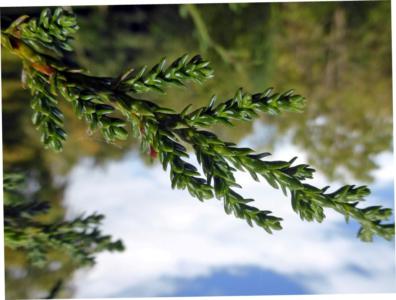Fitzroya
(Fitzroya)

Description
Fitzroya is a monotypic genus in the cypress family. The single living species, Fitzroya cupressoides, is a tall, long-lived conifer native to the Andes mountains of southern Chile and Argentina, where it is an important member of the Valdivian temperate rain forests. Common names include alerce ("larch" in Spanish), lahuán (Spanish, from the Mapuche Native American name lawal), and Patagonian cypress. The genus was named in honour of Robert FitzRoy. F. cupressoides is the largest tree species in South America, normally growing to 40-60 m, but occasionally more than 70 m in Argentina, and up to 5 m in trunk diameter. Its rough pyramidal canopy provides cover for the southern beech, laurel and myrtle. The largest known living specimen is Alerce Milenario in Alerce Costero National Park, Chile. It is more than 60 m tall, with a trunk diameter of 4.26 m. Much larger specimens existed before the species was heavily logged in the 19th and 20th centuries; Charles Darwin reported finding a specimen 12.6 m in diameter. The leaves are in decussate whorls of three, 3-6 mm long (to 8 mm long on seedlings) and 2 mm broad, marked with two white stomatal lines. The cones are globose, 6-8 mm in diameter, opening flat to 12 mm across, with nine scales in three whorls of three. Only the central whorl of scales is fertile, bearing 2-3 seeds on each scale; the lower and upper whorls are small and sterile. The seeds are 2-3 mm long and flat, with a wing along each side. The seeds mature 6-8 months after pollination. In 1993 a specimen from Chile, "Gran Abuelo" or "Alerce Milenario", was found to be 3622 years old, making it the second oldest fully verified (by counting growth rings) age for any living tree species, after the bristlecone pine. A team of researchers from the University of Tasmania found fossilized foliage of a Fitzroya species on the Lea River of northwest Tasmania. The 35-million-year-old (Oligocene) fossil was named F. tasmanensis. The finding demonstrates the ancient floristic affinities between Australasia and southern South America, which botanists identify as the Antarctic flora. About 40 to 50 thousand years ago, during the interstadials of the Llanquihue glaciation, Fitzroya and other conifers had a much larger and contineous geographical extent than at present including the eastern lowlands of Chilo- Island and the area west of Llanquihue Lake. At present Fitzroya grow mainly at some altitude above sea level. Fitzroya stands near sea level are most likely relicts.
Taxonomic tree:







